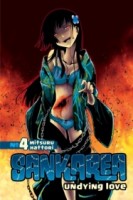My News and Review
Last week I announced the winner of the Vinland Saga manga giveaway. The post also includes a list of the manga with memorable snowy scenes that were mentioned during the contest. (Just in case you haven’t had enough snow where you are this winter.) And speaking of Makoto Yukimura’s Vinland Saga, I also reviewed the second omnibus of the manga. I’m really loving the series and enjoyed the second volume even more than I did the first. Over the weekend I reviewed Mieko Kanai’s award-winning novel Oh, Tama! which I greatly enjoyed. I know quite a few people who find it to be a boring work, but I found it to be delightfully low-key with a quirky sense of humor.
As for news and interesting reading seen online this week: The fourth issue of the international edition of Monkey Business will be released later this month. I quite enjoy Monkey Business, so I’m looking forward to it. Seven Seas answered a question about some of the decisions that go into licensing manga for omnibus release over on its Tumblr. At Organization Anti-Social Geniuses, Justin posted a great List of Where You Can Buy Anime/Manga in 2014. Hooded Utilitarian’s Ng Suat Tong writes about some of the best online comics criticism of 2013, including some great articles on manga that I hadn’t previously come across.
Quick Takes
 Dictatorial Grimoire, Volume 1: Cinderella by Ayumi Kanou. I have a feeling that Dictatorial Grimoire may very well be one of those manga that is so bad that it’s good. The story is admittedly a bit of a mess and sometimes doesn’t even make a whole lot of sense. However, I can’t deny that I had fun reading the manga. It’s all sorts of ridiculous. (I’m not sure that all of it is entirely intentional, though.) Otogi Grimm is the descendant of the Brothers Grimm which turns out to be a rather dangerous thing to be. The Brothers made a pact with demons offering up the lives of their descendants in exchange for the stories that formed the basis of their famous fairy tales. Many of those demons—such as the progenitor’s of Cinderella and Snow White—are now after Otogi in one way or another. He does seem to maintain some control over them, though it’s never explained how he learned, developed, or perhaps inherited this power. I did love that Cinderella is a complete masochist, although that fact is used mostly as a gag rather than for any meaningful characterization. I was, however, amused.
Dictatorial Grimoire, Volume 1: Cinderella by Ayumi Kanou. I have a feeling that Dictatorial Grimoire may very well be one of those manga that is so bad that it’s good. The story is admittedly a bit of a mess and sometimes doesn’t even make a whole lot of sense. However, I can’t deny that I had fun reading the manga. It’s all sorts of ridiculous. (I’m not sure that all of it is entirely intentional, though.) Otogi Grimm is the descendant of the Brothers Grimm which turns out to be a rather dangerous thing to be. The Brothers made a pact with demons offering up the lives of their descendants in exchange for the stories that formed the basis of their famous fairy tales. Many of those demons—such as the progenitor’s of Cinderella and Snow White—are now after Otogi in one way or another. He does seem to maintain some control over them, though it’s never explained how he learned, developed, or perhaps inherited this power. I did love that Cinderella is a complete masochist, although that fact is used mostly as a gag rather than for any meaningful characterization. I was, however, amused.
 Fairy Tail, Volume 34 by Hiro Mashima. The thirty-fourth volume of Fairy Tail gets off to a good start with the conclusion of Natsu’s confrontation with the Saber Tooth Guild. Then it’s back to the Grand Magic Games for the third day of competition. After a nice buildup to the day’s challenge event, called Pandemonium, Erza’s epic battle is largely reduced to a two-page spread. More time is spent on what basically amounts to target practice for the other teams than on what could have been a glorious combat sequence; it was extremely disappointing. Some of the other fights in this volume fare better, but others are completely rushed through. I’m more interested in the plots going on behind the scenes than I am in the tournament itself, but it seems that to some extent Mashima has given up on the Grand Magic Games. Even the event challenges, which were initially interesting because they required some actual thought and strategy to be put into them in addition to magic and martial skill, have become little more than all-out brawls in this volume. That, too, was a rather disappointing development.
Fairy Tail, Volume 34 by Hiro Mashima. The thirty-fourth volume of Fairy Tail gets off to a good start with the conclusion of Natsu’s confrontation with the Saber Tooth Guild. Then it’s back to the Grand Magic Games for the third day of competition. After a nice buildup to the day’s challenge event, called Pandemonium, Erza’s epic battle is largely reduced to a two-page spread. More time is spent on what basically amounts to target practice for the other teams than on what could have been a glorious combat sequence; it was extremely disappointing. Some of the other fights in this volume fare better, but others are completely rushed through. I’m more interested in the plots going on behind the scenes than I am in the tournament itself, but it seems that to some extent Mashima has given up on the Grand Magic Games. Even the event challenges, which were initially interesting because they required some actual thought and strategy to be put into them in addition to magic and martial skill, have become little more than all-out brawls in this volume. That, too, was a rather disappointing development.
 Manic Love by Satomi Yamagata. Manic Love is a prequel of sorts to Yamagata’s Fake Fur; it delves deeper into the back story of Maki Sonoda, an important side character. Yamagata jokes in the afterword that she had challenged herself to write a manga that was half nude scenes, so there’s quite a bit of sex in Manic Love. But it’s actually handled quite tastefully and the sex scenes are an important part of the manga and the themes with which Yamagata is working. As was the case with Fake Fur, Manic Love explores the relationship between romantic love and sexual desire and how they can influence each other. Sex is used as a form of communication and connection between the characters in addition to being something that they enjoy. One of the things that I particularly liked about Manic Love is that each chapter it told from a different characters’ point of view. Maki is in what is probably best described as a sort of love triangle, but it’s one without hard feelings or anger. It’s interesting to be able to see that unusual relationship from multiple perspectives, including one from someone who is outside of that triangle entirely.
Manic Love by Satomi Yamagata. Manic Love is a prequel of sorts to Yamagata’s Fake Fur; it delves deeper into the back story of Maki Sonoda, an important side character. Yamagata jokes in the afterword that she had challenged herself to write a manga that was half nude scenes, so there’s quite a bit of sex in Manic Love. But it’s actually handled quite tastefully and the sex scenes are an important part of the manga and the themes with which Yamagata is working. As was the case with Fake Fur, Manic Love explores the relationship between romantic love and sexual desire and how they can influence each other. Sex is used as a form of communication and connection between the characters in addition to being something that they enjoy. One of the things that I particularly liked about Manic Love is that each chapter it told from a different characters’ point of view. Maki is in what is probably best described as a sort of love triangle, but it’s one without hard feelings or anger. It’s interesting to be able to see that unusual relationship from multiple perspectives, including one from someone who is outside of that triangle entirely.




